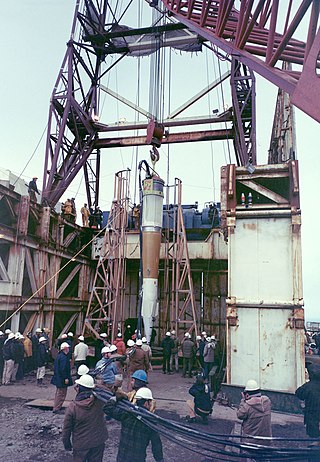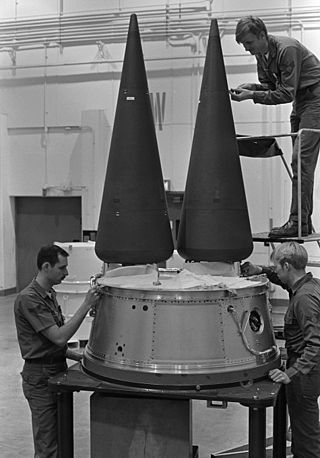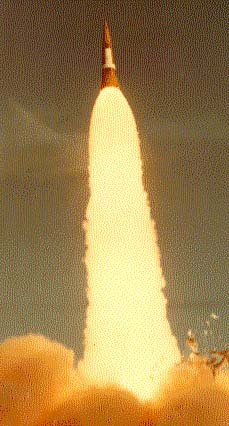
An anti-ballistic missile (ABM) is a surface-to-air missile designed to counter ballistic missiles. Ballistic missiles are used to deliver nuclear, chemical, biological, or conventional warheads in a ballistic flight trajectory. The term "anti-ballistic missile" is a generic term for a system designed to intercept and destroy any type of ballistic threat; however, it is commonly used for systems specifically designed to counter intercontinental ballistic missiles (ICBMs).

An intercontinental ballistic missile (ICBM) is a ballistic missile with a range greater than 5,500 kilometres (3,400 mi), primarily designed for nuclear weapons delivery. Conventional, chemical, and biological weapons can also be delivered with varying effectiveness, but have never been deployed on ICBMs. Most modern designs support multiple independently targetable reentry vehicle (MIRVs), allowing a single missile to carry several warheads, each of which can strike a different target. The United States, Russia, China, France, India, the United Kingdom, Israel, and North Korea are the only countries known to have operational ICBMs.
A neutron bomb, officially defined as a type of enhanced radiation weapon (ERW), is a low-yield thermonuclear weapon designed to maximize lethal neutron radiation in the immediate vicinity of the blast while minimizing the physical power of the blast itself. The neutron release generated by a nuclear fusion reaction is intentionally allowed to escape the weapon, rather than being absorbed by its other components. The neutron burst, which is used as the primary destructive action of the warhead, is able to penetrate enemy armor more effectively than a conventional warhead, thus making it more lethal as a tactical weapon.

A multiple independently targetable reentry vehicle (MIRV) is an exoatmospheric ballistic missile payload containing several warheads, each capable of being aimed to hit a different target. The concept is almost invariably associated with intercontinental ballistic missiles carrying thermonuclear warheads, even if not strictly being limited to them. An intermediate case is the multiple reentry vehicle (MRV) missile which carries several warheads which are dispersed but not individually aimed. All nuclear-weapon states except Pakistan and North Korea are currently confirmed to have deployed MIRV missile systems. Israel is suspected to possess or be in the process of developing MIRVs.

Amchitka is a volcanic, tectonically unstable and uninhabited island in the Rat Islands group of the Aleutian Islands in southwest Alaska. It is part of the Alaska Maritime National Wildlife Refuge. The island, with a land area of roughly 116 square miles (300 km2), is about 42 miles (68 km) long and 1 to 4 miles wide. The area has a maritime climate, with many storms, and mostly overcast skies.

Missile defense is a system, weapon, or technology involved in the detection, tracking, interception, and also the destruction of attacking missiles. Conceived as a defense against nuclear-armed intercontinental ballistic missiles (ICBMs), its application has broadened to include shorter-ranged non-nuclear tactical and theater missiles.

The Safeguard Program was a U.S. Army anti-ballistic missile (ABM) system designed to protect the U.S. Air Force's Minuteman ICBM silos from attack, thus preserving the US's nuclear deterrent fleet. It was intended primarily to protect against the very small Chinese ICBM fleet, limited Soviet attacks and various other limited-launch scenarios. A full-scale attack by the Soviets would easily overwhelm it. It was designed to allow gradual upgrades to provide similar lightweight coverage over the entire United States over time.

The maneuverable reentry vehicle is a type of warhead for ballistic missiles that is capable of maneuvering and changing its trajectory.

The LIM-49 Spartan was a United States Army anti-ballistic missile, designed to intercept attacking nuclear warheads from intercontinental ballistic missiles at long range and while still outside the atmosphere. For actual deployment, a five-megaton thermonuclear warhead was planned to destroy the incoming ICBM warheads. It was part of the Safeguard Program.

The Sprint was a two-stage, solid-fuel anti-ballistic missile (ABM), armed with a W66 enhanced-radiation thermonuclear warhead used by the United States Army during 1975–76. It was designed to intercept incoming reentry vehicles (RV) after they had descended below an altitude of about 60 kilometres (37 mi), where the thickening air stripped away any decoys or radar reflectors and exposed the RV to observation by radar. As the RV would be traveling at about 5 miles per second, Sprint needed to have phenomenal performance to achieve an interception in the few seconds before the RV reached its target.

The W78 is an American thermonuclear warhead with an estimated yield of 335–350 kilotonnes of TNT (1,400–1,460 TJ), deployed on the LGM-30G Minuteman III intercontinental ballistic missile (ICBM) and housed in the Mark 12A reentry vehicle. Minuteman III initially carried the older W62 warhead with a yield of 170 kilotonnes of TNT (710 TJ), but starting in December 1979 and ending in February 1982, some W62 were replaced with the W78. It is publicly estimated that 1083 warheads were manufactured.

The W62 was an American thermonuclear warhead designed in the 1960s and manufactured from March 1970 to June 1976. Used on some Minuteman III ICBMs, it was partially replaced by the W78 starting in December 1979, and fully replaced by W87 warheads removed from MX Peacekeeper missiles and retired in 2010.
A penetration aid is a device or tactic used to increase an aircraft's capability of reaching its target without detection, and in particular intercontinental ballistic missile (ICBM) warhead's chances of penetrating a target's defenses.

Cannikin was an underground nuclear weapons test performed on November 6, 1971, on Amchitka island, Alaska, by the United States Atomic Energy Commission. The experiment, part of the Operation Grommet nuclear test series, tested the unique W71 warhead design for the LIM-49 Spartan anti-ballistic missile. With an explosive yield of almost 5 megatons of TNT (21 PJ), the test was the largest underground explosion ever detonated by the United States.

Nike Zeus was an anti-ballistic missile (ABM) system developed by the United States Army during the late 1950s and early 1960s that was designed to destroy incoming Soviet intercontinental ballistic missile warheads before they could hit their targets. It was designed by Bell Labs' Nike team, and was initially based on the earlier Nike Hercules anti-aircraft missile. The original, Zeus A, was designed to intercept warheads in the upper atmosphere, mounting a 25 kiloton W31 nuclear warhead. During development, the concept changed to protect a much larger area and intercept the warheads at higher altitudes. This required the missile to be greatly enlarged into the totally new design, Zeus B, given the tri-service identifier XLIM-49, mounting a 400 kiloton W50 warhead. In several successful tests, the B model proved itself able to intercept warheads, and even satellites.

Nike-X was an anti-ballistic missile (ABM) system designed in the 1960s by the United States Army to protect major cities in the United States from attacks by the Soviet Union's intercontinental ballistic missile (ICBM) fleet during the Cold War. The X in the name referred to its experimental basis and was supposed to be replaced by a more appropriate name when the system was put into production. This never came to pass; in 1967 the Nike-X program was canceled and replaced by a much lighter defense system known as Sentinel.

Sentinel was a proposed US Army anti-ballistic missile (ABM) system designed to provide a light layer of protection over the entire United States, able to defend against small ICBM strikes like those expected from China, or accidental launches from the USSR or other states. The system would have seventeen bases, each centered on its Missile Site Radar (MSR) and a computerized command center buried below it. The system was supported by a string of five long-range Perimeter Acquisition Radars (PAR) spread across the US/Canada border area and another in Alaska. The primary weapon was the long-range Spartan missile, with short range Sprint missiles providing additional protection near US ICBM fields and PAR sites. The system would initially have a total of 480 Spartan and 192 Sprint missiles.
Nuclear blackout, also known as fireball blackout or radar blackout, is an effect caused by explosions of nuclear weapons that disturbs radio communications and causes radar systems to be blacked out or heavily refracted so they can no longer be used for accurate tracking and guidance. Within the atmosphere, the effect is caused by the large volume of ionized air created by the energy of the explosion, while above the atmosphere it is due to the action of high-energy beta particles released from the decaying bomb debris. At high altitudes, the effect can spread over large areas, hundreds of kilometers. The effect slowly fades as the fireball dissipates.

Hardpoint was a proposed short-range anti-ballistic missile (ABM) system conceived by ARPA and developed by the US Army under ARPA's Project Defender program. Hardpoint was designed to exploit the relatively low accuracy that Soviet ICBMs had, which would make destroying missile silos difficult. The idea was to only shoot at warheads which would be expected to impact within lethal distance of silos, ignoring the rest and allowing them to hit the ground. This acted as a force multiplier, allowing a small number of interceptors to offset a large number of Soviet missiles.
















